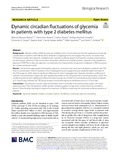Resumen
Background: Diabetes mellitus (DM) has glucose variability that is of such relevance that the appearance of vascular
complications in patients with DM has been attributed to hyperglycemic and dysglycemic events. It is known that
T1D patients mainly have glycemic variability with a specifc oscillatory pattern with specifc circadian characteristics
for each patient. However, it has not yet been ...
[++]
Background: Diabetes mellitus (DM) has glucose variability that is of such relevance that the appearance of vascular
complications in patients with DM has been attributed to hyperglycemic and dysglycemic events. It is known that
T1D patients mainly have glycemic variability with a specifc oscillatory pattern with specifc circadian characteristics
for each patient. However, it has not yet been determined whether an oscillation pattern represents the variability of
glycemic in T2D. This is why our objective is to determine the characteristics of glycemic oscillations in T2D and gener‑
ate a robust predictive model.
Results: Showed that glycosylated hemoglobin, glycemia, and body mass index were all higher in patients with T2D
than in controls (all p<0.05). In addition, time in hyperglycemia and euglycemia was markedly higher and lower in
the T2D group (p<0.05), without signifcant diferences for time in hypoglycemia. Standard deviation, coefcient of
variation, and total power of glycemia were signifcantly higher in the T2D group than Control group (all p<0.05). The
oscillatory patterns were signifcantly diferent between groups (p=0.032): the control group was mainly distributed
at 2–3 and 6 days, whereas the T2D group showed a more homogeneous distribution across 2–3-to-6 days.
Conclusions: The predictive model of glycemia showed that it is possible to accurately predict hyper- and hypo‑
glycemia events. Thus, T2D patients exhibit specifc oscillatory patterns of glycemic control, which are possible to
predict. These fndings may help to improve the treatment of DM by considering the individual oscillatory patterns of
patients. [--]
Materias
Glycemia,
Diabetes mellitus,
Circadian rhythm,
Oscillations,
Continuous glucose monitoring
Publicado en
Biological Research (2022) 55:37
Departamento
Universidad Pública de Navarra. Departamento de Ciencias de la Salud /
Nafarroako Unibertsitate Publikoa. Osasun Zientziak Saila
Entidades Financiadoras
This study was supported by the “Agencia Nacional de Investigación y Desarrollo (ANID)”, through Anillo ACT210083. DCA was funded by grant Fondecyt de Iniciación #11220870 and by Minera Escondida Ltda. MEL2203.




